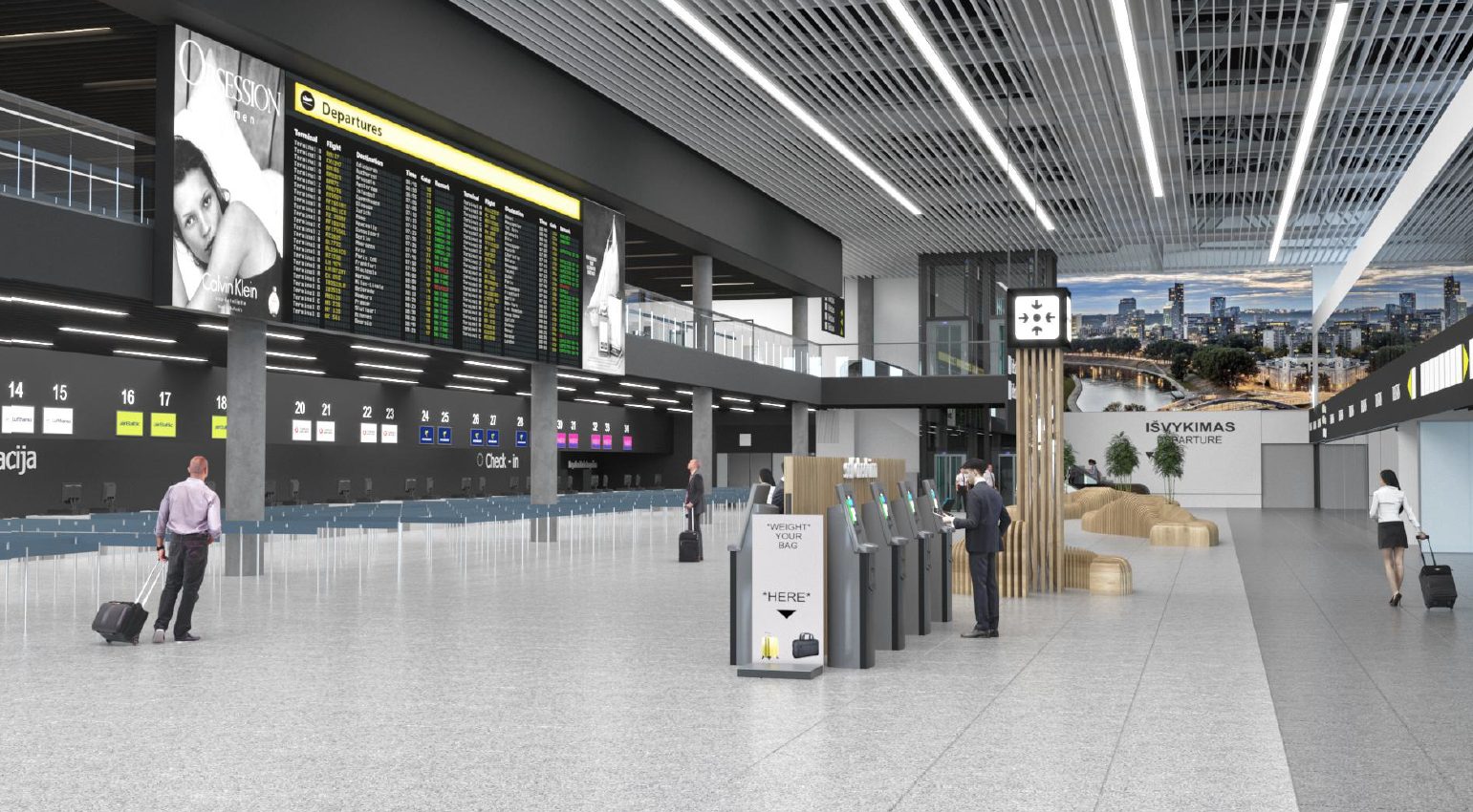Project File: A closer look at the new departure terminal at Vilnius Airport
- Like
- Digg
- Del
- Tumblr
- VKontakte
- Buffer
- Love This
- Odnoklassniki
- Meneame
- Blogger
- Amazon
- Yahoo Mail
- Gmail
- AOL
- Newsvine
- HackerNews
- Evernote
- MySpace
- Mail.ru
- Viadeo
- Line
- Comments
- Yummly
- SMS
- Viber
- Telegram
- Subscribe
- Skype
- Facebook Messenger
- Kakao
- LiveJournal
- Yammer
- Edgar
- Fintel
- Mix
- Instapaper
- Copy Link
Posted: 7 February 2023 | Vilnius Airport | No comments yet
The new departure terminal at Vilnius Airport in Lithuania is currently under construction and will be open in 2025, the airport takes a closer look at the project and explains why the new terminal is going to set new standards of passenger experience and state-of-the-art technology.
Together with the start of construction of the new departure terminal at Vilnius Airport, Lithuanian Airports will also open a new page of activity. According to Arno Dūmans, Head of the operations and infrastructure department of Lithuanian Airports, the new terminal will be the most modern airport terminal not only in the Lithuanian network, but also in the entire Baltic region, and the completion of this project will allow the conversion of existing terminals to continue in the future.
“Even six years ago, all forecasts indicated that the passenger flow would grow rapidly in the future. The pandemic may have postponed the previous plans in terms of time, but currently aviation has returned to the growth of its volumes and the needs remain the same, so we want to increase the throughput of Vilnius Airport passengers, which means ensuring high-quality and technologically advanced service. The construction of the new terminal is already underway at full capacity,” said Arnas Dūmanas.
The first passengers of the new terminal will arrive in 2025
Speaking about the stage of preparation for construction, the representative of Lithuanian Airports recalls the year 2017. According to him, at that time, the design and technological limits of the existing infrastructure were reached, which, at that time, still allowed to serve the growing number of passengers comfortably.
“In 2017 we served more than four million passengers passengers per year at Vilnius Airport. At peak times, the terminals handled about 10 flights or 1,400 passengers per hour. Even then, we were at the limit of possibilities, because all passengers had to pass through the old terminal, through the aviation security check, check-in procedures for flights. The luggage systems also no longer met the highest quality standards. Based on the current trends, we could predict that the number of passengers will at least double in the future, so we had to make a strategic decision on how to proceed – to remodel the old terminal or build a new one,” said Arnas
According to Arnas, the possibility of renovating the old terminal was considered, but it was faced with a lack of space and the infrastructure was not suitable for implementing new technologies. It was also clearly understood even then that the expansion of the terminals into the depth of the platform, started several decades ago and later, was a wrong choice. Then a decision was made to build a new terminal next to the old terminal, which would essentially solve the problems that had arisen. According to Arnas, the transformation of the old terminal would have only amortised the emerging challenges and would continue the established problems in the future. In addition, the work would be practically impossible without disrupting the airport’s operations.
“Both in the consideration stage, and today, when we are already carrying out the construction of the new terminal, one of the main tasks remains to ensure that the activities of Vilnius Airport do not stop due to the ongoing works. We cannot afford to close the capital’s airport for a few years and only then have a new terminal. Our priority has always been to maintain business continuity with work of this magnitude. Although modernisation plans and the start of construction had to be adjusted due to the pandemic, the preparatory work did not stop, so today we can expect that the first passengers of the new departure terminal will leave already at the beginning of 2025,” said Dūmanas.
He added that the construction site has been prepared since the end of 2022. During 2023-2024 the structure of the building should be erected. As Arnas stated, in 2023 we will have the opportunity to touch and feel the building of the new terminal, and in 2024 most of the technological solutions will be implemented, the interior of the terminal and its access will be installed. Later, there will be testing work, so it is expected that already in 2025. In the first quarter, the first passenger will be able to test the new departure terminal.
In the next stages – conversion of existing terminals
Although the new terminal will be the most modern building in all branches of Lithuanian Airports, it will help to solve the mistakes made in the development of the airport in the past and will help to avoid possible challenges in the future. According to Arna, the design of the old terminal limited the possibilities of development.
“Part of the development problems were programmed long ago, as the existing passenger terminals were wrongly expanded in several stages to the side of the platform – just forward, instead of parallel to the platform, which would solve many current problems. It also limited our ability to expand both the boarding galleries and the entire terminal in the way it should be expanded – through an efficient passenger path, through clarity of functions. The new terminal solves all these problems and sets the tone for further development and reconstruction of existing terminals”, he added.
In the near future, the new departure terminal at Vilnius Airport will ensure the possibility of parallel expansion to the southern part on a modular basis, as well as the reconstruction of the old terminals.
“While we were carrying out preparations, we implemented new technological and process improvement solutions in the old terminal, but the new terminal will be a completely new quality bar in terms of both services provided and opportunities for passengers. The terminal will have double the bandwidth compared to the old one. The expansion of check-in places, the renewal of the baggage conveyor system and the development of aviation security posts will allow us to increase the throughput of passengers twice – we will be able to serve about 2,400 passengers per hour.”
According to the Director of the Operations and Infrastructure Department of Lithuanian Airports, after the construction of the new terminal, it will be possible to expand passenger services. For example, the new terminal will be equipped with a unified, modern, efficient and twice as permeable baggage system than the one in the old terminal
Also, the new terminal will pay a lot of attention to the automation of operations and processes – a baggage self-service system will appear, when the passenger will be able to register and hand in his baggage himself, without the help of a check-in agent, and automatic baggage scanning will also appear, which will allow to determine whether the baggage is safe, which will reduce the chance of human error.


Credit: Lithuanian Airports
Attention to environmental protection
According to Arnas, a lot of attention is paid to environmental protection during the implementation of the construction project of the new departure terminal at Vilnius Airport. As one of the distinctive features of the project, he mentions the international BREEAM certificate, which indicates compliance with the requirements of a “green” building.
“By granting this certificate to the new departure terminal at Vilnius Airport, we gained an advantage over many competitors in the aviation sector, as only a small number of airports can boast of having this certificate. We applied the standards of the BREEAM certificate both when planning the project itself and when implementing measures that would allow us to ensure compliance with the requirements in subsequent stages as well, for example during construction and its use.”
The new building, based on BREEAM standards, will use five times less heating energy than current typical buildings. It will also be environmentally friendly – the solutions used in the project are based on renewable energy, for example, the planned places for solar panels. These solutions will also contribute to the realization of the long-term goals of the airport – to become a climate-neutral airport.
“One of the indicators of the BREEAM certificate is the indicator of climate neutrality – this includes the amounts of energy for heating and cooling, water consumption, indoor environment, generated pollution, compliance of the materials used with the concept of sustainability, waste management, ecology, design and construction management processes. At each stage of project implementation, we set ourselves the highest standards and aim to become an airport generating zero emissions,” commented Arnas.
The transport scheme will change
The new departure terminal at Vilnius Airport will become a completely new standard passenger experience and the quality of services provided, therefore, when planning the project, not only the spaces of the terminal itself, but also its accesses are taken into account. As the representative of Lithuanian Airports stated, the traffic scheme in front of the airport will also be restructured as a result. This will make it easier to navigate the transport economy and optimise the transport system.
“We are currently facing a situation where the terminal accesses are divided into many lots. Some are intended for long-term parking, others for short-term. The current scheme is quite complex, so when planning the accesses of the new terminal, we set the optimisation of the traffic system as one of the goals. A decision was made to organise circular traffic next to the new terminal – this will allow increasing traffic capacity,” said Arnas.
According to him, in order to optimise transport flows, considerable attention will also be paid to the integration of public transport and carriers into the transport scheme. In addition, all currently existing parking lots will be combined into one whole – this solution will double the traffic capacity compared to the current one.
All the latest information about the new Vilnius airport terminal can be found on the special subpage www.vilnius-airport.lt/naujas-terminalas
Related topics
Airport construction and design, Airport development, Baggage handling, Passenger volumes, Self-service


















